Introduction
When credit rating agencies assign ratings, they don’t just stop at giving a letter grade like AAA or BBB. They also provide signals about the future direction of those ratings. Two of the most important signals are rating outlooks and watchlists (sometimes called CreditWatch or rating watch).
- An outlook reflects the likely direction of a rating over the medium term (6–24 months).
- A watchlist indicates the rating is under active review for possible immediate change (days to weeks).
Understanding these signals is critical for businesses, investors, and lenders who rely on ratings to make financial decisions.
What is a Rating Outlook?
A rating outlook shows whether a rating is expected to improve, worsen, or remain stable over the coming months to years. Common labels include:
- Positive: Upgrade is more likely than downgrade.
- Negative: Downgrade is more likely than upgrade.
- Stable: No significant change expected.
- Developing/Evolving: Direction uncertain.
Outlooks are not rating changes but forward-looking indicators. They communicate an agency’s view of risks and opportunities that could affect creditworthiness in the future.
What is a Watchlist (CreditWatch)?
A watchlist is more immediate. It means the rating is under active review and could change quickly — usually within days or weeks. Watchlists are often triggered by:
- Major transactions (mergers, acquisitions, divestitures).
- Breach of financial covenants.
- Unexpected events such as litigation, regulatory actions, or liquidity shocks.
- Sudden deterioration in business or financial performance.
While outlooks signal directional bias, watchlists signal urgency.
Outlook vs. Watchlist — Key Differences
| Feature | Rating Outlook | Rating Watchlist |
| Time Horizon | Medium-term (6–24 months) | Short-term (days to weeks) |
| Purpose | Indicates likely direction (positive/negative/stable) | Marks rating under immediate review |
| Triggers | Macroeconomic trends, projected financials, policy changes | Event-driven shocks, major transactions, covenant breaches |
| Strength of Signal | Moderate (probability, not certainty) | Strong (imminent change likely) |
Why Do Agencies Use Them?
Credit rating agencies use outlooks and watchlists to:
- Provide transparency to investors and issuers.
- Signal risks and expectations without making constant rating changes.
- Allow markets to prepare for future adjustments.
- Help issuers take corrective action before a downgrade actually happens.
What Triggers an Outlook?
Typical triggers for changing an outlook include:
- Forecasted improvements or deterioration in financial ratios.
- Anticipated regulatory or policy changes.
- Industry-wide trends (e.g., commodity price cycles).
- Company-specific plans like debt reduction, acquisitions, or capital raising.
What Triggers a Watchlist?
A company may be placed on a watchlist when:
- A large acquisition or restructuring is announced.
- Debt repayment or refinancing is uncertain.
- Regulatory penalties or lawsuits emerge.
- There are signs of acute liquidity stress.
In such cases, agencies need to verify facts quickly before revising the rating.
Implications for Issuers and Investors
For issuers:
- A negative outlook may increase borrowing costs and investor caution.
- Being on a watchlist can make refinancing or short-term funding difficult.
- Transparency with rating agencies, investors, and lenders is key to limiting damage.
For investors:
- Outlooks help anticipate potential rating moves over time.
- Watchlists signal immediate risks and should trigger a close review of exposure.
How Should Issuers Respond?
If placed on an outlook or watchlist:
- Engage with the rating agency — provide full and timely disclosures.
- Demonstrate liquidity strength — highlight credit lines, cash reserves, and contingency measures.
- Communicate with investors and lenders — align messaging to reduce market uncertainty.
- Act quickly — refinance early, renegotiate covenants, or strengthen governance if needed.
Proactive steps can shorten the time under review and even prevent a downgrade.
FAQs
Q: Is an outlook the same as a rating change?
No. An outlook indicates likely direction; the rating remains the same until formally revised.
Q: Does being on a watchlist always mean downgrade?
No. Outcomes may be an upgrade, downgrade, or affirmation after review.
Q: Can outlooks apply to short-term ratings?
Generally, outlooks relate to long-term ratings. Short-term instruments are more often handled with watchlists.
Key Takeaways
- Outlooks = medium-term guidance (6–24 months).
- Watchlists = short-term alerts of imminent rating change.
- Both are crucial tools for transparency and risk management.
- Issuers should use them as opportunities to engage, reassure, and take corrective action.
Why This Matters for Businesses in India
For Indian companies, being on a watchlist or given a negative outlook can directly affect access to debt and equity markets, borrowing costs, and investor confidence. With SEBI’s strict disclosure norms, agencies in India provide detailed rationale for these signals — making it even more important for issuers to be proactive.
As India’s Largest Credit Rating Advisors and Leading IPO Advisors, FinMen Advisors works with businesses to prepare, position, and protect their credit profile, ensuring that market signals like outlooks and watchlists are managed strategically.


